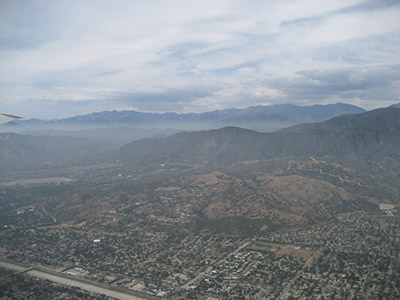A .gov website belongs to an official government organization in the United States.
A lock () or https:// means you've safely connected to the .gov website. Share sensitive information only on official, secure websites.
2 November 2016
adapted from the story by CIRES Communications

Long-term atmospheric measurements demonstrate vehicle emission control strategies in the U.S. and Europe.
The United States and the European Union take markedly different approaches to vehicle emissions controls, and the evidence is in the air, according to a new study. The work, published in Geophysical Research Letters, shows distinct differences in vehicle pollution trends in U.S. megacities, where regulations tend to target air quality, and European ones, where the target tends to be greenhouse gases.
The paper also shows that a new, NOAA-developed accounting of emissions from cars and other vehicles could improve air quality and climate assessments by providing more accurate inputs.
"The current inventory used in climate assessments fails to capture long-term trends and regional differences in motor vehicle emissions in U.S. and European cities. That could explain why global chemistry models don't correctly predict global ozone pollution levels," said Birgit Hassler, who led the work as a CIRES scientist at CSD. "We may be able to help these models do better."
To quantify emissions that form the pollutant ozone, the research team studied decades of atmospheric observations and two emission inventories. Cars and other vehicles burning fossil fuels emit an alphabet soup of chemicals that can react to form ozone pollution, which can damage people's lungs and harm plants including crops. The researchers analyzed observations of some of those chemical ingredients – nitrogen oxides and carbon monoxide – collected during decades-long monitoring programs in United States and European megacities.
They started with the Los Angeles Basin, where the California Air Resources Board (CARB) has been tracking air pollution for decades, and where the NOAA and CIRES team has a long history of making measurements on the ground and from the air during periodic field studies. The researchers then looked at ambient measurements taken in other cities, including New York, London, and Paris.
The patterns that emerged reflected the different control strategies taken by the United States and Europe, the paper reported. "In these long-term emissions datasets, we can actually see the impacts of different pollution control strategies," said Hassler. "Vehicle emissions trends vary between different regions and countries worldwide, partly because of different policies: Some nations focused on reducing chemicals that cause smog, while others aimed to reduce climate-changing emissions from vehicles." For example, over the past several decades, U.S. cities have focused on improving air quality by controlling the ozone precursors emitted by motor vehicles. As a result, passenger cars here mainly run on gasoline and use catalytic converters to limit emissions of nitrogen oxides, carbon monoxide, and volatile organic compounds. The study documents this trend in the LA Basin, where these emissions have been decreasing since the 1970s.
By contrast, in Europe the strategy has been to reduce vehicle emissions of greenhouse gases, including carbon dioxide. Consequently, European nations have encouraged the use of diesel automobiles, which have higher fuel efficiency and consequently lower carbon dioxide emissions. According to the U.S. Department of Energy, diesel vehicles can often go about 20 to 35 percent farther on a gallon of fuel than their gasoline counterparts.
However, diesels tend to emit more nitrogen oxides than comparable gasoline vehicles. "Our study provides an explanation for the findings that nitrogen oxide levels aren't going down in London and Paris compared to Los Angeles," said Hassler. "We're not the first to show that, but we are first to show that with data from regulatory monitoring networks."
Using these same observations of nitrogen oxides and carbon monoxide, the researchers also evaluated the quality of two different emission inventories, which quantify the amount of pollutants released into the atmosphere by various types of sources. Such inventories ultimately inform air quality forecasts and climate simulations, including those done by the Intergovernmental Panel on Climate Change (IPCC).
In the new paper, the researchers looked at an inventory called MACCity, which estimates the amount of pollution released by motor vehicles per mile driven and focuses on national rather than city emissions estimates. And they also evaluated a NOAA-developed inventory that calculates emissions based on gallons of gasoline or diesel burned, using real-world, per-vehicle emissions measured from thousands of vehicles in different cities.
The researchers found the NOAA fuel-based inventory represented long-term emissions trends in Los Angeles and captured U.S. vehicle pollution control strategies better than the MACCity inventory did. The team thinks some problems they found with MACCity may also exist in other global inventories. Evaluating global inventories with measurements from regional monitoring networks could lead to improvements in IPCC and other climate assessments and also ozone pollution predictions.
Birgit Hassler, Brian McDonald, Gregory Frost, Agnes Borbon, David Carslaw, Kevin Civerolo, Claire Granier, Paul Monks, Sarah Monks, David Parrish, Ilana Pollack, Karen Rosenlof, Thomas Ryerson, Erika von Schneidemesser, and Michael Trainer, Analysis of long-term observations of NOx and CO in megacities and application to constraining emissions inventories, Geophysical Research Letters, doi:10.1002/2016GL069894, 2016.
Long-term atmospheric NOx/CO enhancement ratios in megacities provide evaluations of emission inventories. A fuel-based emission inventory approach that diverges from conventional bottom-up inventory methods explains 1970–2015 trends in NOx/CO enhancement ratios in Los Angeles. Combining this comparison with similar measurements in other U.S. cities demonstrates that motor vehicle emissions controls were largely responsible for U.S. urban NOx/CO trends in the past half century. Differing NOx/CO enhancement ratio trends in U.S. and European cities over the past 25 years highlights alternative strategies for mitigating transportation emissions, reflecting Europe's increased use of light-duty diesel vehicles and correspondingly slower decreases in NOx emissions compared to the U.S. A global inventory widely used by global chemistry models fails to capture these long-term trends and regional differences in U.S. and Europe megacity NOx/CO enhancement ratios, possibly contributing to these models' inability to accurately reproduce observed long-term changes in tropospheric ozone.